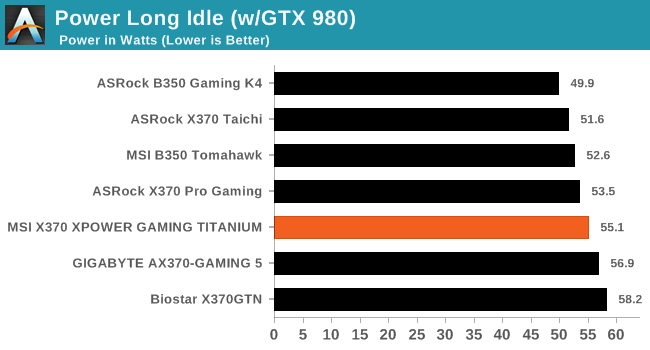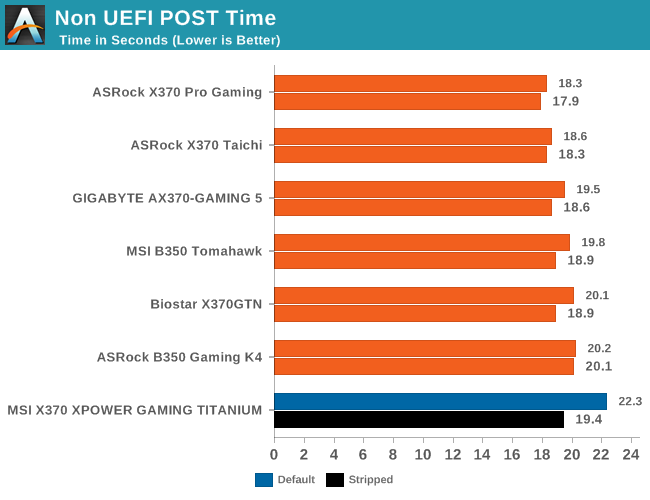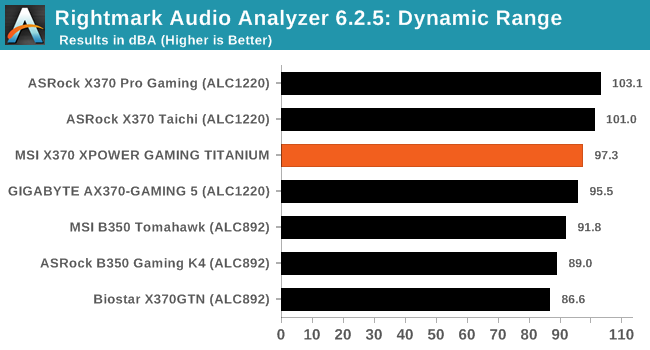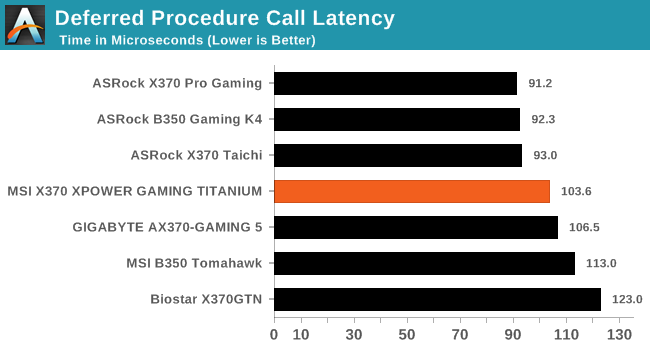The MSI X370 XPower Gaming Titanium Motherboard Review: A Silver Flagship
by Gavin Bonshor on April 13, 2018 8:00 AM ESTSystem Performance
Not all motherboards are created equal. On the face of it, they should all perform the same and differ only in the functionality they provide - however, this is not the case. The obvious pointers are power consumption, but also the ability for the manufacturer to optimize USB speed, audio quality (based on audio codec), POST time and latency. This can come down to manufacturing process and prowess, so these are tested.
Power Consumption
Power consumption was tested on the system while in a single ASUS GTX 980 GPU configuration with a wall meter connected to the Thermaltake 1200W power supply. This power supply has ~75% efficiency > 50W, and 90%+ efficiency at 250W, suitable for both idle and multi-GPU loading. This method of power reading allows us to compare the power management of the UEFI and the board to supply components with power under load, and includes typical PSU losses due to efficiency. These are the real world values that consumers may expect from a typical system (minus the monitor) using this motherboard.
While this method for power measurement may not be ideal, and you feel these numbers are not representative due to the high wattage power supply being used (we use the same PSU to remain consistent over a series of reviews, and the fact that some boards on our test bed get tested with three or four high powered GPUs), the important point to take away is the relationship between the numbers. These boards are all under the same conditions, and thus the differences between them should be easy to spot.



Power consumption on the XPower was around the expected levels, with it falling just below that of ASRock premium gaming motherboard under OCCT. Due to the high amount of controllers integrated onto the board and plenty of connections, the board at idle sits high among our previously tested AM4 boards.
Non-UEFI POST Time
Different motherboards have different POST sequences before an operating system is initialized. A lot of this is dependent on the board itself, and POST boot time is determined by the controllers on board (and the sequence of how those extras are organized). As part of our testing, we look at the POST Boot Time using a stopwatch. This is the time from pressing the ON button on the computer to when Windows starts loading. (We discount Windows loading as it is highly variable given Windows specific features.)

The XPower's POST time sits a couple of seconds slower when compared to the boards in the above graph, with the stripped boot being a good 3 seconds faster than with everything enabled at default.
Rightmark Audio Analyzer 6.2.5
Rightmark:AA indicates how well the sound system is built and isolated from electrical interference (either internally or externally). For this test we connect the Line Out to the Line In using a short six inch 3.5mm to 3.5mm high-quality jack, turn the OS speaker volume to 100%, and run the Rightmark default test suite at 192 kHz, 24-bit. The OS is tuned to 192 kHz/24-bit input and output, and the Line-In volume is adjusted until we have the best RMAA value in the mini-pretest. We look specifically at the Dynamic Range of the audio codec used on the rear panel of the board.

Despite the OP-AMP and audio design, it didn't really translate much in our dynamic range testing. We're still having issues testing THD+N on our AMD boards, unfortunately.
DPC Latency
Deferred Procedure Call latency is a way in which Windows handles interrupt servicing. In order to wait for a processor to acknowledge the request, the system will queue all interrupt requests by priority. Critical interrupts will be handled as soon as possible, whereas lesser priority requests such as audio will be further down the line. If the audio device requires data, it will have to wait until the request is processed before the buffer is filled.
If the device drivers of higher priority components in a system are poorly implemented, this can cause delays in request scheduling and process time. This can lead to an empty audio buffer and characteristic audible pauses, pops and clicks. The DPC latency checker measures how much time is taken processing DPCs from driver invocation. The lower the value will result in better audio transfer at smaller buffer sizes. Results are measured in microseconds.

At present, none of the manufacturers of the boards tested so far have been optimized for DPC latency, but the XPower performed second best behind the ASRock boards.










19 Comments
View All Comments
T1beriu - Friday, April 13, 2018 - link
BIOS Build Date: 09/19/2017.WOW.
T1beriu - Friday, April 13, 2018 - link
I see that MSI released 2 BIOS versions since then.Ian Cutress - Friday, April 13, 2018 - link
That's partly my fault. Gavin tested this board back in late January, wrote it up over Feb, and it's been in my to-edit list for a few weeks. The two BIOS revisions were 1/29 and 3/19, mostly relating to new processor support and some more memory tweaks, as well as Win7 support.ManuelDiego - Friday, April 13, 2018 - link
Plus we are like 1 week away of X470, right? Not sure i see the point of releasing this board now, TBH.Ian Cutress - Friday, April 13, 2018 - link
Bottom of first page, questions answered.ManuelDiego - Friday, April 13, 2018 - link
I see, thanks for the addendum, Dr. Cutress.Topweasel - Friday, April 13, 2018 - link
Those are kind of BS answers for a lack of effort to review the products when they launched over a year ago. This was MSI's Launch flagship motherboard, they only now (ish) gave you a board to review? I doubt that, considering it's price, and all of the review samples that AMD gave out were with the Crosshair, MSI would have been handing these out like candy hoping reviews would get people to get this over the RoG.Above you noted that the review was basically finished 4 months ago. Back when people would have actively purchasing X370 boards. While I am sure that the mobo companies will sell this next to the new boards, without steep discounts (ones that a Premium board like this are unlikely to get to make them less interesting than a mid level X470 board) the default purchasing habits will be the new series. Topping it off people buying this late into the cycle want to know more about quirks, long term issues, Bios update history, support level type stuff to make sure they are getting the most stable platform on which to build their computer around. Stuff that is missing because this isn't a long term review, it's a normal review near the end of its natural cycle.
I know the real answer and while disappointing you shouldn't be ashamed of. We want the best technical information and the best approach. You give us that, and the real answer being you were backed up with all of the hardware launches last year that you prioritized products that mattered to the larger portion of your readership I think most of us understand. Otherwise considering it was pretty much a year on the dot that you started reviewing products ancillary to the Ryzen release. That the secrecy behind reviewing products this late into the cycle has more to do with Purch's relationship with Intel and not down to workload.
Ryan Smith - Friday, April 13, 2018 - link
"That the secrecy behind reviewing products this late into the cycle has more to do with Purch's relationship with Intel and not down to workload. "Let me be 100% crystal clear here: AnandTech's editorial calendar is set by me. Purch has taken an extremely light hand to AnandTech overall, and has never dictated what content we should run.
It does a massive disservice to Ian, Gavin, and my other editors when anyone accuses, insinuates, or otherwise implies that they are acting with ulterior, unethical motives. These are some of the hardest working people I know - Ian in particular - and it was my choice alone in determining our editorial priorities. Which yes, meant having Ian work on some other things (like digging into the CTS story) ahead of editing motherboard reviews.
Topweasel - Friday, April 13, 2018 - link
I want to point out I wasn't actually suggesting that was the case. I am sure it's all about hands available and deciding what products will get the most re-viewership (for example more I7's than Ryzen 7's sold means more people would be interested in Z270/370 reviews than X370). But it's better to actually say that than try to play it off like all of a sudden you got 10 AM4 300 series boards in a couple months before the refresh and that there is this demand for reviews of the product. This isn't the usually week or two later with more in depth information, this is nearing the end of a products viable marketable sales (but as noted not the end of sales).But dancing around the actual reason for the delay and considering the poorness of the timing (almost exactly a year after launch). It causes people to generate conspiracy theories. Without knowing better that would be the one that would come to my head. Why almost exactly a year, what is the significance of the year? It almost seems like a time limited exclusivity deal like games some times have. It would then spiral from there, why? Well Purch and Intel have a relationship about very high level advertising through regular media deal going on.
Sure some fans aren't going to like being told their product doesn't generate enough views. But obviously a choice was already made that was going that their readership wasn't worth the ROI in man hours. So it's not like that guy not wanting to read a review after being told that is going impact you that much since again his market was to small for the effort anyways. But in the end most reasonable people are going to welcome more transparency there rather than looking for another reason to call Anandtech a schill site. I don't think it is. Never have.
Just think about that in the future. It's one of the things that was great about Anandtech back in the day and will keep the site a worthy one coming back. Don't pull the punches on reviews, don't dance around choices made. Just be as straightforward and technical as possible. Doing otherwise invites critism and over scrutinization.
Qasar - Saturday, April 14, 2018 - link
Topweasel here is a better idea....if you think you can do better then anandtech does now.. then how about you start your own review site, and do them yourself based on what you feel your readers will want at any given time.
the staff here have stated over and over again, they decide what gets reviewed, when and when it is posted on here, should x370 and AM4 related stuff have been reviewed months ago.. yes.. but we dont know their schedule, work load, or whats in the queue to be reviewed or posted. i remember a post a while back that said they have a new reviewer for amd related product and are getting him up to speed, that could of been part of the delay... either way. i keep coming back here cause of the quality of these reviews and write ups, and how deep the guys and anandtech have always gone into something on the tech side.. and i will keep coming back for that.. even if a lot of it.. i dont understand cause its above my pay grade :-) this is one of the best places to go for reviews and the tech inside a lot of the products on here